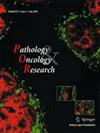Long term follow-up of refractory/relapsed hairy cell leukaemia patients treated with low-dose vemurafenib between 2013 and 2022 at the Department of Internal Medicine and Oncology, Semmelweis University
IF 2.3
4区 医学
Q3 ONCOLOGY
引用次数: 0
Abstract
Introduction: Hairy cell leukemia (HCL) is an indolent B-cell lymphoproliferative disease. BRAF V600E mutation is detected in nearly all classical HCL cases which offers the possibility of targeted therapy. Objective: The aim of our study was to assess the efficacy of low-dose vemurafenib as well as to assess the long term outcome of HCL patients treated with this drug at the Department of Internal Medicine and Oncology at Semmelweis University. Methods: We report on 10 patients with classical HCL treated with low-dose vemurafenib at our Department between 2013 and 2022. Results: As a result of fixed time low-dose vemurafenib treatment, 5 of 10 patients (5/10) achieved partial remission, 4 (4/10) had stable disease, and 1 (1/10) had MRD positivity. No patients achieved complete remission. The median progression-free survival was 28.5 months while the overall survival was 82 months. Conclusion: We confirm that low dose of vemurafenib is effective and safe in the vast majority of patients with HCL. This small-molecule oral treatment allows to gain valuable time—months or even years—before further, usually parenteral treatment options have to be given or before previous treatment has to be repeated. There are also promising data supporting the combination of vemurafenib with other drugs for the treatment of HCL patients which could provide even further possibility to bridge treatment.Semmelweis大学内科和肿瘤科2013年至2022年间接受低剂量vemurafenib治疗的难治性/复发性毛细胞白血病患者的长期随访
毛细胞白血病(HCL)是一种惰性b淋巴细胞增生性疾病。BRAF V600E突变几乎在所有经典HCL病例中检测到,这为靶向治疗提供了可能。目的:我们研究的目的是评估低剂量vemurafenib的疗效,以及评估在Semmelweis大学内科和肿瘤科接受该药物治疗的HCL患者的长期预后。方法:我们报告了2013年至2022年在我科接受低剂量vemurafenib治疗的10例经典HCL患者。结果:经固定时间低剂量vemurafenib治疗,10例患者中5例(5/10)部分缓解,4例(4/10)病情稳定,1例(1/10)MRD阳性。没有患者达到完全缓解。中位无进展生存期为28.5个月,总生存期为82个月。结论:我们证实,低剂量vemurafenib对绝大多数HCL患者是有效和安全的。这种小分子口服治疗可以为患者赢得宝贵的时间——几个月甚至几年——在必须进行进一步的静脉注射治疗之前,或者在必须重复之前的治疗之前。也有有希望的数据支持vemurafenib与其他药物联合治疗HCL患者,这可能为桥接治疗提供进一步的可能性。
本文章由计算机程序翻译,如有差异,请以英文原文为准。
求助全文
约1分钟内获得全文
求助全文
来源期刊
CiteScore
6.30
自引率
0.00%
发文量
134
审稿时长
4-8 weeks
期刊介绍:
Pathology & Oncology Research (POR) is an interdisciplinary Journal at the interface of pathology and oncology including the preclinical and translational research, diagnostics and therapy. Furthermore, POR is an international forum for the rapid communication of reviews, original research, critical and topical reports with excellence and novelty. Published quarterly, POR is dedicated to keeping scientists informed of developments on the selected biomedical fields bridging the gap between basic research and clinical medicine. It is a special aim for POR to promote pathological and oncological publishing activity of colleagues in the Central and East European region. The journal will be of interest to pathologists, and a broad range of experimental and clinical oncologists, and related experts. POR is supported by an acknowledged international advisory board and the Arányi Fundation for modern pathology.

 求助内容:
求助内容: 应助结果提醒方式:
应助结果提醒方式:


